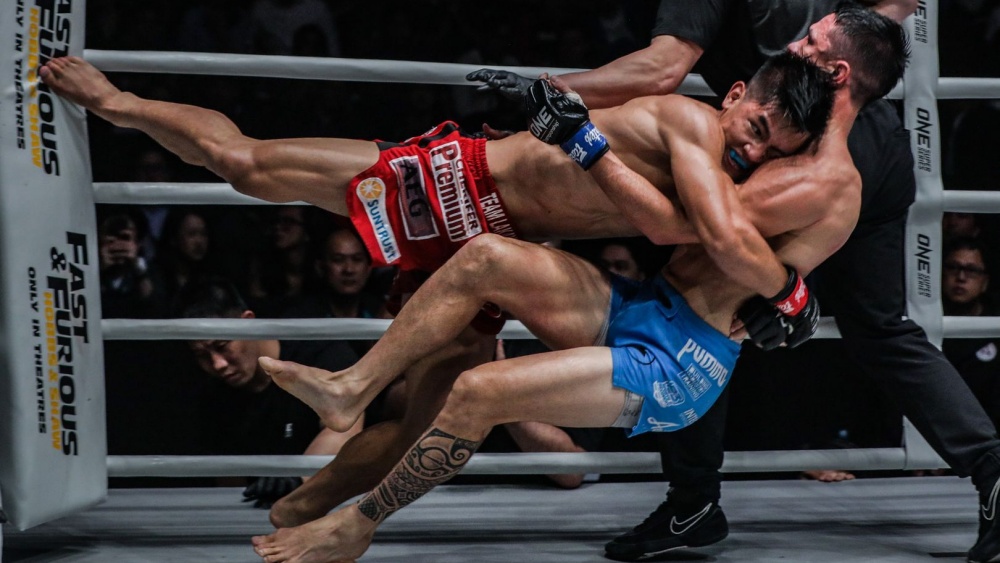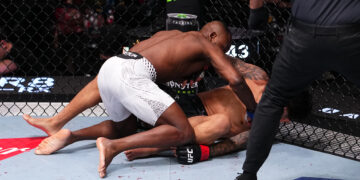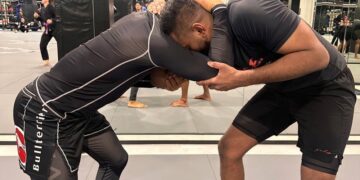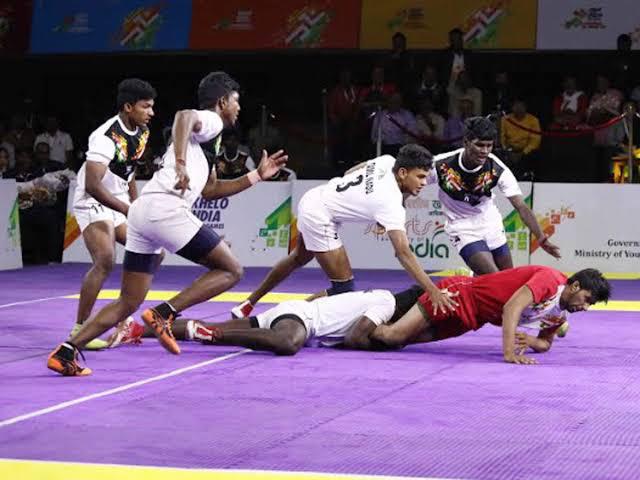
Many strikers don’t think they need to learn how to wrestle until they feel what it’s like to battle a strong grappler. Striking and grappling are the two opposite ends of martial arts training, and neither is more important than the other.
Wrestling is the glue that binds striking and grappling together. It allows you to choose where a fight takes place, a significant advantage in mixed martial arts (MMA).
Some would argue that grappling-based martial arts like wrestling are better suited for self-defense since many altercations end up turning into grappling matches. Still, you can argue that many people get knocked out before that happens.
Even grappling-based styles like Brazilian Jiu-Jitsu (BJJ) sometimes downplay the importance of wrestling. For example, BJJ sparring sessions usually start with both fighters on their knees, removing the need to wrestle. The result? BJJ fighters are pulling guard at world championships because they never bothered to learn takedowns.
This article will help to curb such practices by breaking down some key takedown techniques mixed martial arts fighters and BJJ players should master to take their fighting abilities to the next level.
Essential Takedown Techniques All MMA Fighters And BJJ Heads Should Know
Let’s explore some wrestling techniques that are just as useful in Brazilian Jiu-Jitsu and mixed martial arts settings:
1) The Sprawl
The sprawl should be one of the first wrestling moves MMA fighters learn. It allows you to avoid single-leg and double-leg takedowns by moving your legs out of your opponent’s reach. When done correctly, you also end up on top, allowing you to transition back to standing, lock up submissions like the anaconda choke, or improve to other grappling positions.
Execution: To sprawl, kick your legs back when an opponent shoots in on you. Kick your legs back and thrust downward, pressing your chest into your opponent’s back as you fall to the ground. A well-timed sprawl turns your opponent’s takedown attempt into a massive waste of energy.
2) The Double-Leg Takedown
This is one of the most popular wrestling techniques, and it works in various settings, from street fights to BJJ competitions. One cool thing about the double leg is that it’s almost impossible to defend against when done correctly. Ideally, you want to go for a double leg when an opponent is aggressively coming after you, allowing you to weaponize their forward momentum against them.
Double-leg takedowns at the end of rounds can steal rounds for you, and the technique gives you a direct path to top position in BJJ. Just ensure your head is facing behind your opponent, not looking at the ground, so you don’t get caught in a guillotine.
Execution: Drop levels by bending your knees as if you were squatting, and drop to a knee as you grab the back of your opponent’s legs. Lock your arms if possible and drive your opponent’s upper body back while pulling their legs toward you.
3) The Single-Leg Takedown
The single-leg takedown is much like the double-leg, but you only target one leg. It’s a bit more challenging to learn than the double leg but equally as effective once mastered.
Execution: Drop your levels as you shoot in and go down on one knee, but focus only on the leg closest to you. Wrap your arms around the leg and secure it with your legs. Pivot to the side of the leg you’ve grabbed while dropping your torso to the ground to finish the takedown.
4) The Body Lock Takedown
Fighting in the clinch is a significant part of BJJ and MMA, so learn a few takedowns from there. Single and double-leg takedowns can be performed from clinched positions, but there’s always a risk of getting a knee to the face in MMA. The body lock takedown is a much safer option.
Execution: While clinched up, pummel your arms to establish double underhooks. Now, lock your arms behind your opponent’s back using any grip you’re comfortable with. Tighten the lock and use it to pick your opponent’s feet off the ground before turning them over.
5) The Blast Double
The blast double is the aggressive cousin of the double-leg takedown. It’s a powerful technique that often gets opponents on the ground before they realize what’s happening. The technique is most effective when done unexpectedly and explosively.
Execution: Change levels and explode into your opponent like a football player tackling someone. Drive your torso into them while pulling their legs up with your hands. The key is to hit your opponent with so much explosive energy that you could lift them in the air even if you failed to secure their legs.
Wrestling Drills To Add To Your Training
Some wrestling drills that will help improve your takedowns and takedown defense include:
1) Sprawl Drills
Add solo sprawling drills to your training routine and drill with training partners shooting for your legs while you sprawl.
Drilling sprawls regularly helps to build muscle memory, so your body automatically knows what to do when someone shoots in on you.
2) Penetration Steps
Drill shooting in with penetration steps so often that you can automatically shoot in for takedowns any time you want with excellent technique.
3) Wall Work
Practice pummeling and working for takedowns while your training partner has their back against a wall if you’re a mixed martial artist. Also, spend time with your back against a wall while your training partner tries to take you down.
4) Chain Wrestling
Practice transitioning from one takedown to another when sparring since wrestling is rarely clean. You might take an inexperienced grappler down with your first takedown attempt, but you’ll need to chain multiple takedowns to make experienced grapplers make mistakes that leave them on their backs.
Effective Takedowns Take Your MMA And BJJ Game To The Next Level
You don’t need to be a lifelong wrestler to secure or defend against takedowns effectively. It’s about focusing on the specific aspects of wrestling that complement and enhance your BJJ or MMA skills. Whether you’re a striker transitioning to MMA, a BJJ practitioner looking to round out your game, or someone wanting to defend against takedowns in a self-defense scenario, understanding key wrestling principles can significantly improve your ability to control the pace of the fight. Mastering the basics of wrestling, such as proper level changes, timing, and positioning, can make all the difference in turning the tide of a match, giving them a competitive edge in both offensive and defensive situations.
You may also like:
How To Stay Safe And Effective Off Your Back In MMA
The armbar is one of the most powerful and versatile submissions in BJJ. It is a fundamental technique taught to beginners yet remains a favorite among advanced practitioners and world champions. The armbar is effective…
“Punch a black belt in the face; he becomes a brown belt. Punch him again, purple…” These are the words of Carlson Gracie, one of the pioneers of mixed martial arts. Playing guard in Brazilian…
Brazilian Jiu-Jitsu is widely recognized for its physical benefits, such as improved strength, flexibility, and endurance. However, beyond its physical aspects, BJJ also provides significant mental health benefits. In today’s fast-paced world, many people struggle…
Brazilian Jiu-Jitsu is a constantly evolving martial art that rewards those who explore new positions and attacking strategies. The arm saddle is one of the more advanced yet highly effective positions that have gained recognition…
Brazilian Jiu-Jitsu is a constantly evolving martial art. Over the years, practitioners have continually searched for ways to improve their ability to control, sweep, and submit opponents. Among the many guard variations available, the shin-to-shin…
Brazilian Jiu-Jitsu is always evolving, with grapplers constantly finding new ways to blend techniques. Two skills that have gained popularity in modern No-Gi grappling are wrestle-ups and leg locks. At first glance, they seem like…
The switch kick is a fundamental kicking technique used in Muay Thai that has spread to other combat sports like mixed martial arts and kickboxing. It’s a crafty way to turn your lead leg (weaker…
Feeling spent after an intense martial arts training session is something all fighters relate to. Rubbery legs, aching shoulders, and sore arms are often signs you’ve put in lots of hard work in the gym….
Singapore is known for its diverse and delicious food options, but eating out can get expensive. As inflation news hits the headlines regularly, you might wonder whether you can still find an affordable dining place…
It doesn’t sound like much, but journaling your martial arts journey helps you to reach your full potential. Dedicating yourself to martial arts often means learning several techniques weekly, drilling everything you’ve learned, and sparring…
Unstructured or more commonly known as ‘open’ sparring is a cornerstone of any martial art‘s fight preparation, and it’s the closest thing you can find in any gym to real competition. Structured sparring has its…
Boxing is often perceived as an offensive sport where speed, power, and aggression dictate success. While true in certain aspects, at its highest levels, boxing is just as much about defense and control as it…


































